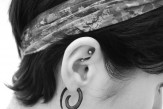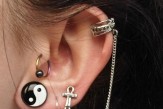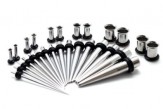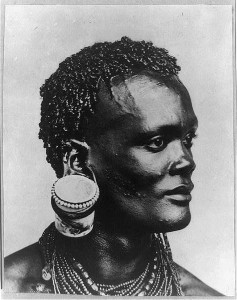Ear stretching and modern culture
Looking at the history of ear stretching and comparing it with modern cultures we can see the similarities in how we seem to give precedence with those that seem to go more extreme levels, many probably wouldn’t agree with me. But we only need to take a quick look into the “scene” to see the similarities
In ancient times, most men wore the jewelry as a status of their placement within their local groups. Obviously as different tribes were widespread and had different forms of body modification, the area placement might differ and the same for materials. But with that said, normally the larger the piercing, would determine that persons power or standing.
Ok I agree that’s not entirely the case in today’s worlds, but there is a similar theme. When visiting any piercing or body modification shop, you can still see the adulteration given to those who go more on the extreme sides of ear stretching. Those supporting larger plugs, tapers or going to the more extreme end in regards to weight and size, still garner most of the attention.
I’ve done it myself when going with friends or visiting one particular shop owner I know. I’ve always got questions for those supporting the largest and most extreme piercings, is it painful? Does it feel heavy? Are you going to go any bigger? I’m not the only one asking these questions too when other’s see the more extreme.
I’ve seen plenty ladies “oohing” and “ahhing” around these individuals too. When you start seeing that sort of response you can imagine that things weren’t so dissimilar in ancient times.
We have plenty of evidence to support that the larger the piercing the more the man was respected in within his community or tribe in times gone past. Looking at such figures as Buddha we can see that the ear stretching was a sign of respect and obviously the jewelry was made from gold. Thus indicating that the more precious the metal or material, the higher the standing the individual had within his group.
We also see that in today’s age, this relates both to men and women. Whether it is gold or silver or even diamonds, these earrings normally determine wealth and a certain social standing by the person who wears them. There is also a level of maturity that comes normally with the wearer.
Women and ear stretching
In the past and especially tribal times, tribe’s women used ear stretching as coming of age and also as decoration.
So let’s look at that in comparison with modern women. Most young women normally get their ears pierced after they become a women so to speak, granted this is happening earlier and earlier in today’s age, but you can still see that this practice was first started in ancient times as a sign a women was in adulthood.
The relationship is clearly there in comparison with today’s women, there is clearly a comparison to be made that when you’re at a certain age that’s considered acceptable to get your ears pierced, you’re also considered to be at a certain level of maturity and woman hood too.
The decoration thing also has a correlation in that in some other countries women who wear large amount of jewelry, and support larger amounts of body modification, appear to have a larger standing in their community too. This is possibly in today’s terms related to the value of that jewelry, but the jewelry use in past times would have been considered of great value too, of that I have no doubt.











I can see what you’re saying and I agree with the majority of it, nice post.
Hi
Most pf ppl stretch their ears, b/c they don’t want to look like all ppl around. It looks really nice, if they don’t use wheels from cars 🙂
Thanks